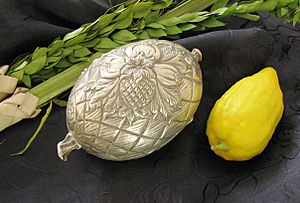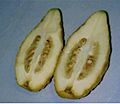Etrog facts for kids
The Etrog (pronounced eh-TROHG) is a special yellow fruit, a type of citron, that Jewish people use during the week-long holiday of Sukkot. It's one of the four special plants, called the four species, that are used in the holiday prayers.
During Sukkot, the etrog is held together with a lulav (palm branch), hadass (myrtle branches), and aravah (willow branches). People take great care to pick the perfect etrog for this important holiday tradition.
Contents
What's in a Name?
The word etrog comes from the Hebrew language. It's pronounced esrog by some Jewish groups. Experts think the Hebrew word came from the Persian word turunj, which also means citron. The Arabic word utroj also means this type of citron.
Etrog Varieties
In modern Hebrew, etrog can mean any kind of citron fruit. However, when people talk about the etrog for the Sukkot holiday, they usually mean specific types that are considered suitable for the ritual. Some plant experts used to think etrog was just one specific type of citron. But different Jewish communities use different varieties of etrogim based on their traditions.
History of Growing Etrogim
Etrogim were grown a lot in the Holy Land during the time of the Second Temple. You can see pictures of etrogim in old artworks from that time, like mosaics in ancient synagogues. They are often shown with other important religious symbols, such as the shofar (ram's horn) or menorah (candelabra). Etrogim also appear on old coins from the Bar Kokhba Revolt.
It's hard to find old evidence of citrus fruits because their seeds and pollen don't last long. But in 2012, scientists found citron pollen from the second century BCE in Israel. This is the earliest proof of etrogim in the area.
Etrogim Around the World
After the fall of Jerusalem in 70 CE, Jewish people who were forced to leave their homeland planted citron orchards wherever the weather was warm enough. This included places like Southern Europe (Spain, Greece, and Italy), North Africa, and Asia Minor.
Jews living in colder areas had to import etrogim. This was often difficult and dangerous because of sea travel. By the 1600s, popular places to get etrogim included the islands of Corsica and Corfu.
Since the late 1850s, an organization in Mandatory Palestine helped etrog farmers sell their fruit to Jews in Europe. While some Jewish communities still preferred etrogim from Italy, Greece, or Yemen, many started buying them from Israel again.
Today, most etrogim for American Jews come from Israel. However, during the shmita year (a special year when the land rests), it can be complicated to export produce from Israel.
There is one commercial etrog grower in the United States named John Kirkpatrick. He is not Jewish but started growing etrogim in California in 1980. He works with a Jewish business partner to ensure the etrogim meet religious requirements. As of 2010, Kirkpatrick had 250 etrog trees and produced about 3,000 suitable etrogim each year.
What Makes an Etrog Kosher?
To be used for the Sukkot ritual, an etrog must meet certain requirements.
The Pitam
The pitam (pronounced pee-TAHM) is a small tip on the end of the etrog. It's made of two parts: a style and a stigma. Usually, the pitam falls off naturally as the fruit grows. An etrog with an intact pitam is considered very special. However, if the pitam naturally falls off during growth, the etrog can still be used.
If the whole pitam breaks off unnaturally, the etrog cannot be used for the ritual. But if only the very tip (the stigma) breaks off, it might still be okay as long as part of the style remains attached.
Keeping the Pitam Intact
A scientist named Eliezer E. Goldschmidt discovered a way to help more pitamim stay on the fruit. He found that a certain chemical could help citrus fruits keep their pitamim fresh and strong. He figured out the right amount of the chemical to use to achieve this.
Etrog Purity
For an etrog to be kosher (acceptable for ritual use), it must be pure. This means it cannot be a graft (two plants joined together) or a hybrid (a mix of two different species). Because of this, only a few traditional varieties are used. To make sure no grafting happens, special etrog farms are carefully watched by rabbis.
Genetic Studies
Scientists have done DNA studies on different etrog varieties. They have confirmed that several traditional types, like the Diamante from Italy, the Greek citron, and the Balady from Israel, are pure and related.
Some other citron varieties, like the Buddha's hand or the Florentine citron, are not used for the ritual. The Corsican citron was not used for a while but has recently become popular again.
Choosing and Growing Etrogim
Besides genetic tests, rabbis also have traditional ways to tell if an etrog is pure and not a hybrid. These methods have been passed down by farmers for many years.
The most common signs of a pure etrog are:
- It has a thick skin, and its inside pulp is small and almost dry.
- Its outer surface is ribbed and has bumps.
- The stem (where it connects to the tree) is slightly sunken inward.
Lemons or other citron hybrids usually don't have all these features.
Another sign, though not as widely accepted, is how the seeds are arranged. In a pure etrog, the seeds usually point straight up and down. In lemons and hybrids, the seeds often lie flat, even if there's plenty of space.
Etrogim are usually grown from cuttings (parts of a plant that are cut and replanted). The tree starts to produce fruit about four years after planting. If grown from a seed, it takes about seven years to bear fruit, and the fruit might be slightly different genetically.
Etrog Customs
To keep the etrog safe during the holiday, people traditionally wrap it in soft flax fibers. They often store it in a special, fancy box, sometimes made of silver.
After the Sukkot holiday, some people believe that eating the etrog or etrog jam can help women have an easy childbirth. A common custom for some Jewish groups is to save the etrog until the holiday of Tu BiShvat. They eat it candied or as a sweet preserve, hoping they will find a beautiful etrog for the next Sukkot. Some families also make jam or liqueur from the etrog. Others make a pomander by sticking cloves into the skin. This can be used as a sweet smell during the havdalah ceremony after Shabbat.
It's important to know that etrogim grown in Israel are not usually meant to be eaten. This is because a lot of pesticides are used when they are grown.
Some breweries even use etrog rinds to make special beers around the Sukkot holiday!
Images for kids
-
Balady citron at a market in Bnei Brak
-
A market selling the Four species in Tel Aviv
-
A man in Mea Shearim checking an etrog
-
At the Western Wall during Sukkot
-
Two Hasidic men in Bnei Brak
-
Benjamin Netanyahu holding an etrog
See also
 In Spanish: Etrog para niños
In Spanish: Etrog para niños











































